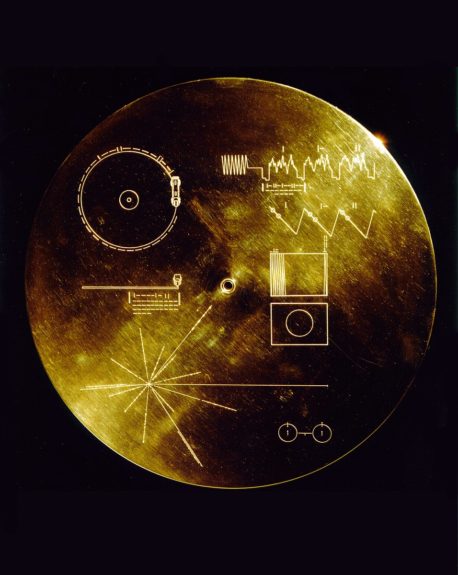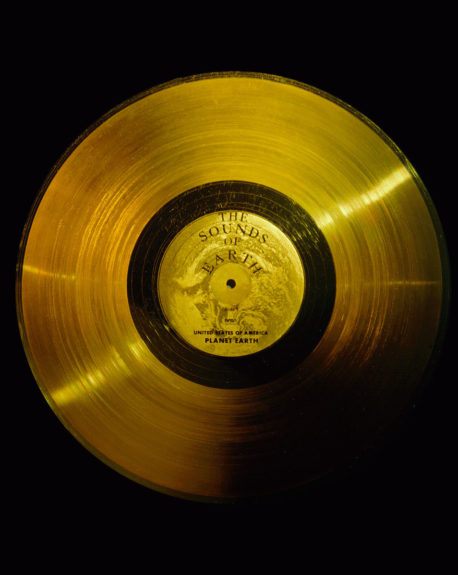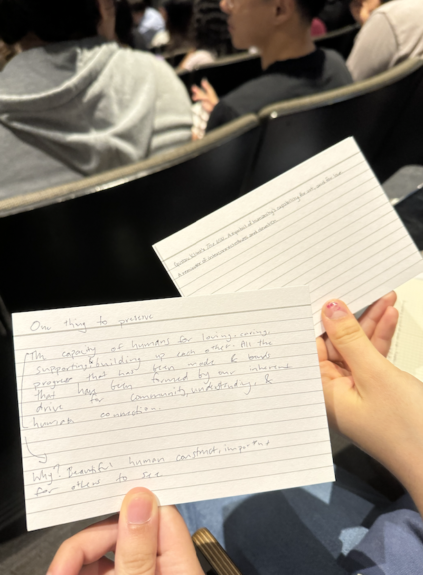On September 19, Bwog News Editor Emma Burris and Staff Writer Lorelei Gorton attended the Voyager Golden Record Experience, an interdisciplinary exploration of humanity’s place in the cosmos.
If you could preserve one thing from our home, what would it be, and why? “Laughter.” “Love.” “The trees.” “The sea.”
If someone in the cosmos hears your voice and can help us, what would you ask of them and why? “Is there a way for us not to destroy ourselves?” “Don’t visit us until we’re ready.”
Sitting in a screening room in Dodge Hall, dozens of attendees scribbled answers onto index cards, which would soon be added to an archive reimagining a 21st-century Golden Record. The original Golden Record, created in 1977, was sent aboard the Voyager 1 and Voyager 2 spacecrafts. Designed as humanity’s legacy to the universe, the Golden Record stores over a hundred images, audio clips of nature and human culture, music, greetings in 55 languages, and mathematical diagrams. (To see the exact contents of the Record, you can visit this link.)
On September 19, NASA and Columbia held an event titled “The Voyager Golden Record Experience” to discuss the impact of the Golden Record and discuss current aspirations for humanity’s future. The event was presented by the School of the Arts’ Film Department and hosted by technologist and media scholar Behrang Garakani (GS ’24).
The evening began with an interactive experience titled “Messages from Home,” a discursive design project first imagined in Columbia’s Digital Storytelling Lab. It’s a well-designed project that has attracted some attention—it’s been shown at the Lincoln Center and featured in a New York Times article. While resonant lo-fi music played softly in the background, Natalia Espinoza (School of the Arts ‘24, BC ‘22) spoke in a smooth, meditative voice alongside a video of the solar system, telling the crowd, “Within the hour we will construct a message for deep space… that will perhaps outlive all of us.”
The audience was then instructed to write down a single item from humanity we would choose to preserve and a message to transmit to the hypothetical aliens discovering the Golden Record. We jotted down our thoughts on index cards, which were then collected and placed in golden boxes. These were glowing on the inside, an effect that was probably due to LEDs but looked just like magic. We were also instructed to call a phone number and leave a voicemail of our message. This recording and written words, we were told, were going towards an archive for a potential future Golden Record.
As we ooh-ed and aah-ed, Garakani welcomed Jon Lomberg, the Design Director for the Golden Record and a long-time collaborator of Carl Sagan’s, on Zoom from his house in Hawaii. Lomberg spoke about the production of the Golden Record, highlighting its uniqueness and cultural longevity even after 50 years. He claimed that while it isn’t always the most famous thing around, it’ll never go out of style. The Record has had books written about it, was anthropomorphized at the Paris Olympics, and is even the subject of a musical in production. Lomberg said this was due to its simplicity for mass understanding and its aspirational, feel-good intent. He stated that the Golden Record, whose cover he designed, would last longer than almost any other work of humanity. (“Almost” felt like a vast understatement—this is an object made to last for more than a billion years.)
The process of constructing and curating the Record was difficult, and marked by constraints. Time was one. Lomberg revealed that the team had only six weeks to decide content, navigate copyright permission, and problem-solve how they could create a durable and decipherable “will” for humanity. Curation was another. As he put it, “You can’t describe the earth in 100 pictures. You can’t describe the earth in 1000 pictures. But what art is about is taking something small to represent the whole.” Technology was the third. The solution of the 1970s was to create a gold-plated copper record. Today’s digital advances, as Dr. Jonathan Jiang talked about in the third part of the event, would now allow us to store multiple terabytes of information—far more storage than was available on the original Record—onto a small glass disk.
Dr. Jiang, a researcher at NASA’s Jet Propulsion Laboratory, shifted the conversation from the achievements of the past to the question of the future. If the Golden Record is ever found, it would have to be by intelligent life with technology much further developed than ours. Since the Voyager probes aren’t on a trajectory to crash into any planets, any aliens interested would have to have their own spacial technology to notice and collect the Golden Record. The chances of extraterrestrial life exist—about 8% of planets in the universe contain the conditions for habitable life—but the chances of intelligent extraterrestrial life are far slimmer. If there is other life out there, who’s to say it’s not just a layer of moss, or a strange type of tree?
Continuing with the topic of intelligent life, Jiang then pointed out a crucial aspect of our own civilization—our insatiable tendency to create and fervently refine tools for our own destruction. He left us with the question of whether or not humanity can surpass the “Great Filter,” a hypothetical future life-altering event. We could be wiped out by factors such as climate change and nuclear war, or we could transform into what Jiang calls a “Type I Civilization,” capable of harnessing all of the planet’s resources. (There are Type II and Type III Civilizations as well: for those interested, you should definitely read up on the Kardashev scale!)
Towards the end of the event, both scientists spoke on the decision for the Golden Record to include only the positive aspects of humanity. “Let’s be remembered for Mozart, not Hitler. That was the logic,” Lomberg said, reflecting on the production of the original Record. According to him, the vast majority of the younger generation has found it incomplete and dishonest for any future Record to show a purely positive picture of the world. One test future Records should pass, Lomberg said, is to be honest and truthful, regardless of what overall connotation is conveyed.
Overall, we left the event feeling inspired and fulfilled. The possibility of any intelligent life far off in our galaxy or the next discovering the Golden Record, or any future records to come, was overwhelming. In a way, it feels almost inevitable, given the vastness of space will ensure the record will likely be found before it’s destroyed. And if another Golden Record is sent out into space, our voices and messages may be on it, preserved for billions of years.
The Golden Record photographs via Wikimedia.
Event photos via Emma Burris.


 0 Comments
0 Comments



